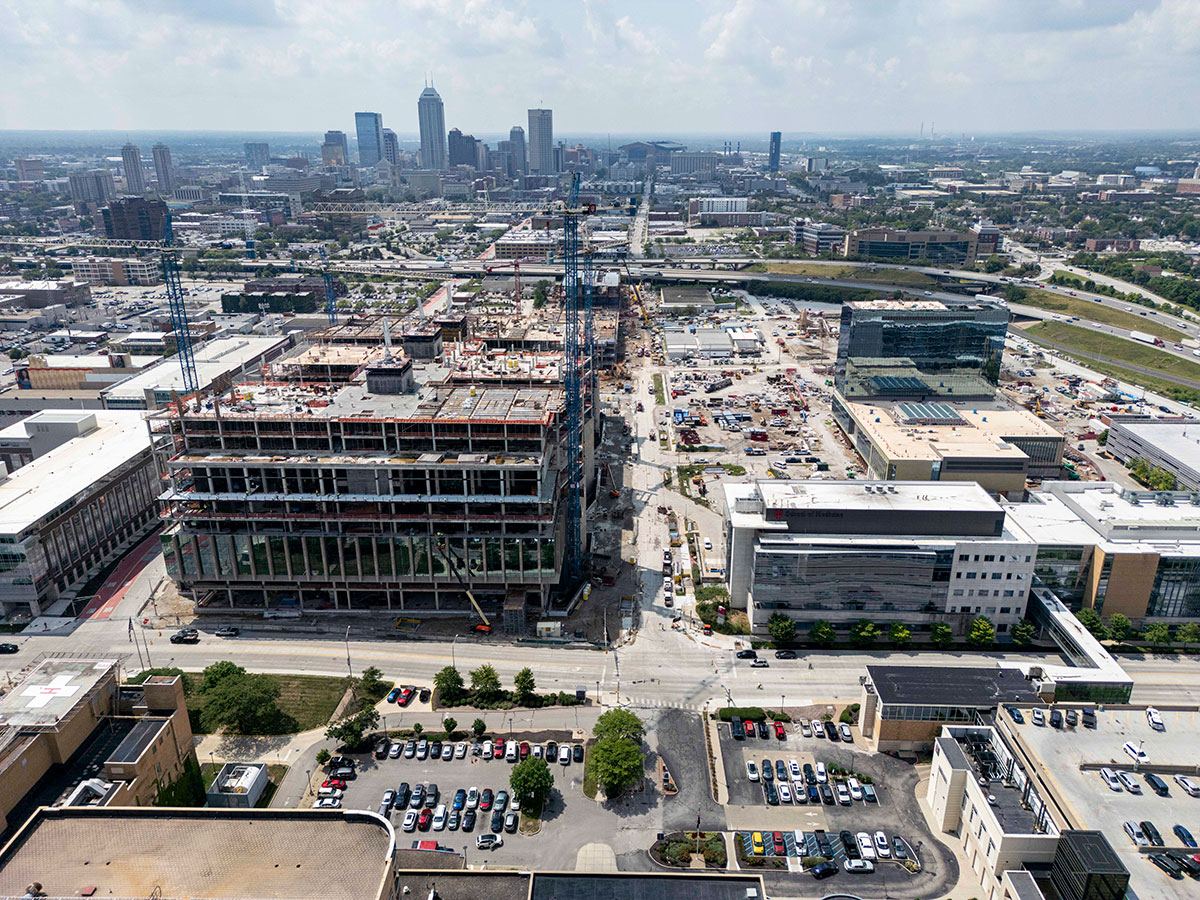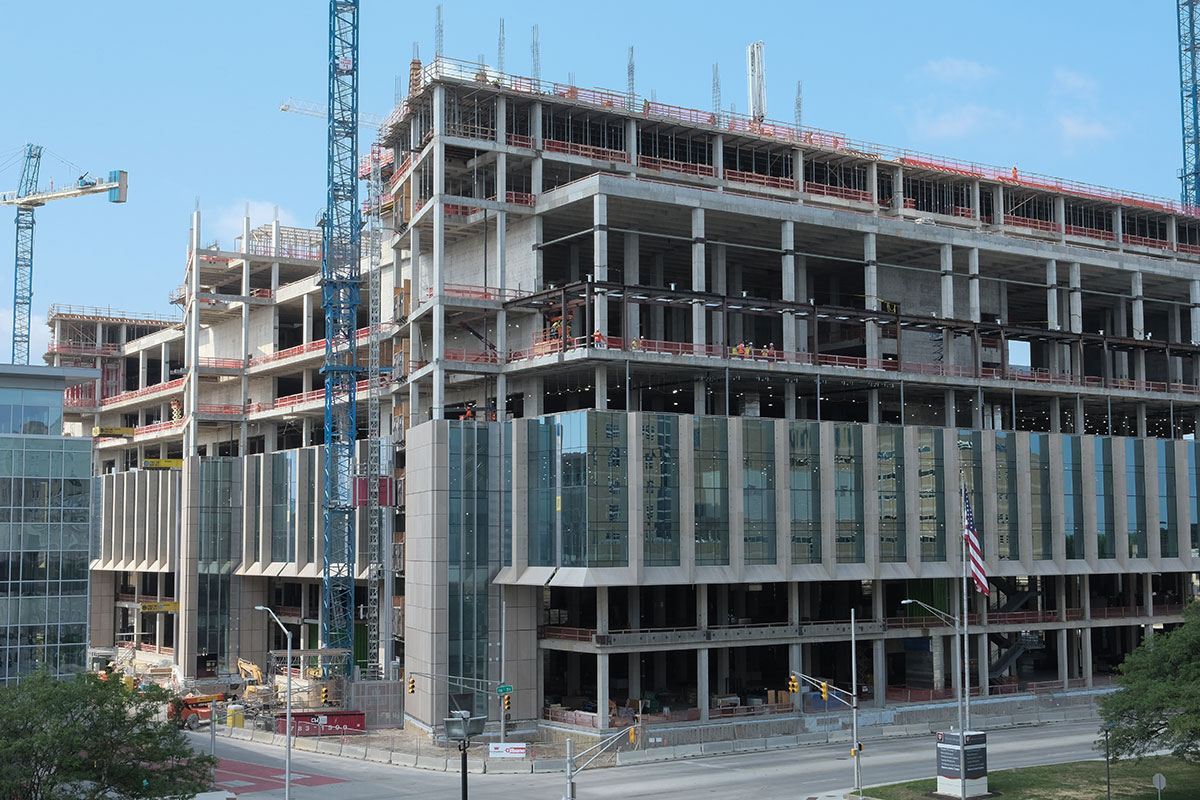Subscriber Benefit
As a subscriber you can listen to articles at work, in the car, or while you work out. Subscribe NowWork on Indiana University Health’s $4.3 billion downtown hospital campus, one of the most expensive construction projects in Indiana history, is set to be finished in late 2027.
Officials with IU Health discussed the progress with IBJ, noting the new hospital, with three 16-story patient towers, should receive its top beam—or be “topped out”—next spring.
The new campus will stretch across a 44-acre site just south of IU Health’s century-old Methodist Hospital, at West 16th Street and North Capitol Avenue. The new hospital will consolidate the existing Methodist Hospital with University Hospital, which sits about 1-1/2 miles southwest on the campus of Indiana University Indianapolis. The eight-block expansion will extend IU Health’s footprint south to 12th Street and from Capitol Avenue to Interstate 65.
The complex will include a medical office building, a support building that will contain parking, a utility plant and retail space. It also will be home to the Indiana University School of Medicine’s education and research building.
IBJ spoke with Dr. Ryan Nagy, president of IU Health’s adult academic health center, and Jim Mladucky, vice president of design and construction. This interview has been edited for clarity and space.
Can you tell me what parts of the existing Methodist Hospital and surrounding buildings are going to be saved and included in this project?
Nagy: When we open the new hospital, our intent is that all clinical activity will be south of 16th Street [in the new hospital and other new buildings]. Nothing in Methodist Hospital, north of 16th Street, and nothing in the University Hospital will be used for clinical care. That does not mean we will not maintain some structures. But as far as clinical activity, seeing patients, they will all be in the new structure.
Can you describe the upcoming difference in patient experience between the new hospital and the existing Methodist Hospital?
Nagy: At a high level, we will have everything in one place—every specialty, every diagnostic component, all the components of care all within one structure. It’s also a structure that’s vertical, as opposed to more horizontal, so the ease of going through the building is greatly improved.
So for example, from any spot in the building, to get to an MRI is less than two minutes, even though it’s 2-1/2 million square feet. Under the current layout, that would be completely impossible.
How large will the new hospital be compared to the existing Methodist and University hospitals?
Nagy: When we merge the two structures, even though we’re building a 2-1/2-million-square-foot building, we’re downsizing 900,000 square feet. But we’re going to be able to take care of as [many] or more patients than we are doing right now. But it’s a much more efficient platform for both staff, patients, families and loved ones to interact with the building as opposed to now.

and from Interstate 65 to Capitol Avenue. (IBJ photo/Mickey Shuey)
Do you have confidence that this new project is on schedule and will open by the end of 2027?
Mladucky: We are definitely on schedule. And we’re hoping to improve that even more. So you know, the weather has really cooperated over the last couple of years. We’ve had very mild winters, which helps a lot. And we’ve got great commitment from our construction partners, and we’ve got the workers on site that we need. Not that we don’t need more, don’t get me wrong.
We’re very confident we’re on schedule and have a good design. We’ve had a lot of work with our caregivers in with other focus groups to make sure that what we’re designing and what we’re building will be what they need to provide the best patient care possible.
What percentage of the project is completed? Do you have a round number?
Mladucky: I would say we’re somewhere between 20% and 25%.
What kind of systems or structural parts have been completed or are well underway?
Mladucky: The concrete frame that’s on the north side of the building, we’re up to the ninth floor. On the south side, we’re at the eighth floor. So it’s continuing to go up, more or less, from north to south. On level three to level four in our stair towers, we have our exterior glass with glazing, our limestone and metal panels are in place and will continue to go up as the structure is being built.
And then on the third floor, because we have that enclosed, we’re able to begin the interior buildout. So we’ve got metal studs and drywall up in quite a bit of that area. We’ve got all of our ductwork, our electrical main runs in place. We’re doing some in-place mockups to confirm the location of light switches and outlets and medical gas outlets and those kinds of things.
So that third floor is our cancer center, so [we’re] setting up those patient rooms in those mockups, making sure they’re what our caregivers need.
You mentioned the cancer center. Is that the equivalent of the Simon Cancer Center? Is that what’s moving over?
Nagy: That’s correct. The cancer center in its entirety will be on this campus on the third floor of the hospital.
And will it still be called the Simon Cancer Center?
Nagy: Yes, it will.
Is this a significant moment for the project?
Mladucky: It’s just a summer update at this point. But you can mark March 2025 on your calendar. That’s when we’ll top out our structure.
In terms of the Capitol View medical office building on the campus, have you disclosed any of the retail clients who you think will take up space on the first floor?
Nagy: I can’t disclose it because we haven’t made any decisions. That part of the process is still ongoing.
When we talked a year or so ago, Jim, you mentioned the possibility of a small grocery store somewhere on the campus. Is that still in the cards?
Mladucky: I’m not sure if that’s in the cards or not. I don’t know if it would be on campus or close by. Obviously, food insecurity is something that we’re focused on, and we want to make sure that we address [it there, and] we think there are other opportunities and maybe better locations that would be off campus.
Can you put these numbers in context? How do 864 beds and 50 operating rooms compare to what you have currently in the combined Methodist and University hospitals?
Nagy: That is roughly equivalent to the footprint we currently have today. However, it’s a much more efficient layout. It actually allows for an expansion of care. We’ll be able to take care of more patients than we are right now by putting [the two hospitals] together.
I am always very careful when I use the word “downsize.” There is no downsizing in clinical care capabilities. What we have downsized is the inefficient parts of buildings that we have to keep cooled, maintain and take care of, and now the savings from that can go into clinical programs.
The main point of saying all that is that it’s a much more efficient platform, and that’s where we’ll be able to drive some value.

So why was the current footprint of Methodist and University hospitals so inefficient by comparison?
Nagy: Well, because they were developed independently. And some parts of those structures go back over 100 years. The vast majority of Methodist and University were developed pre-1997, in which the two structures were not one organization.
[Editor’s note: IU Health was formed in 1997, originally under the name Clarian Health, to combine Methodist, University and Riley Children’s hospitals.]
In addition, the current structure is vertical. Just by going vertical, [that] creates the exceedingly more efficient platform than the current floorplates. Maybe a real example would be, we will not have two kitchens. We will have one.
So the last major announcement on this project, in January of 2023, was about the big expansion of number of beds and floors, which would increase the price about 60%, to about $4.3 billion. Any other big news since then?
Mladucky: We’re staying the course. … We’re building 864 beds. We’ll have 50 [operating rooms]. The emergency department is going to be able to see 88,000 to 95,000 visits annually. We’ll still be one of the top transplant hospitals in the country. We’re making sure that we can continue to provide that, as well as advance that.•
Please enable JavaScript to view this content.




I just had a Total Knee replacement at Methodist. Surgical Team was super. After Surgery was a horrible experience. No one would get me up and moving for 14 hours, ice machine was faulty – so knee was warm overnight. Pressure machine for opposite leg was not connected. For the first 14 hours the answer was “not my job / problem”. Finally I texted the Surgical Team and they came over and got post surgical procedures corrected. A Nursing Manager came to assess and assign blame. My feedback was that management was at fault. Staff was not trained, procedures were not followed. Room was filthy. So how does moving to a new facility change poor training?.
Interesting that IU Health continues to be evasive on what it plans to do with the current Methodist complex north of 16th Street. Obviously, some of the buildings are very old — but the main structure only dates to late 70’s or early 80’s. Why the secrecy?
There’s also the Simon Cancer Center that opened in 2008 that will be abandoned.